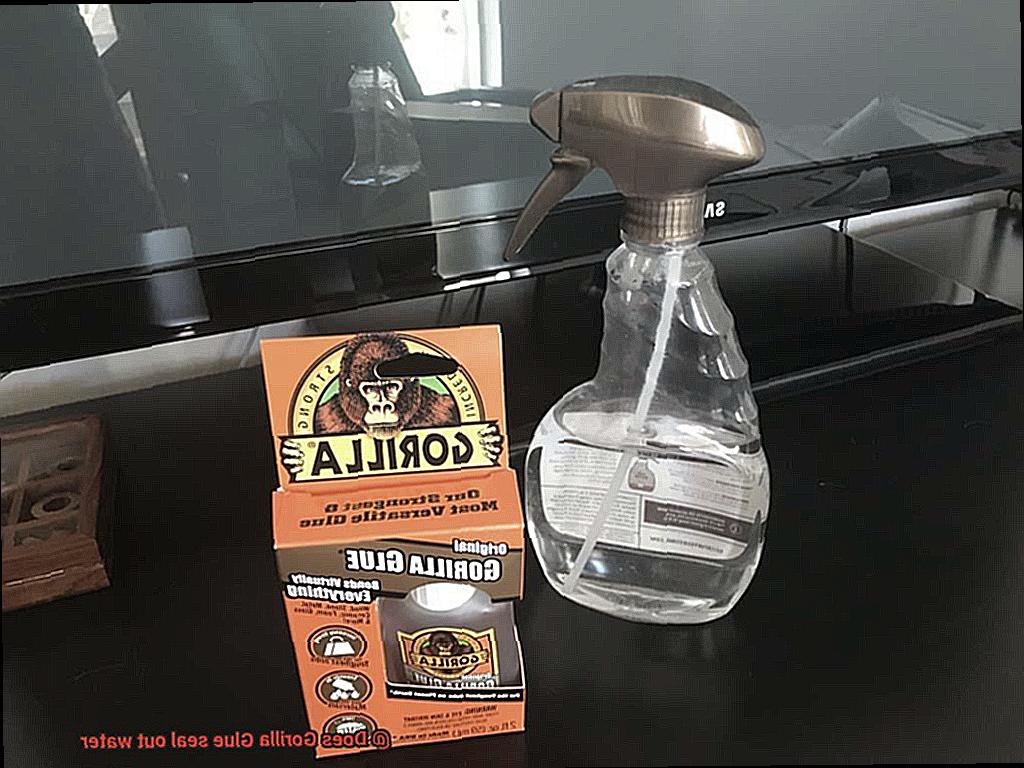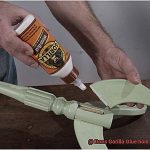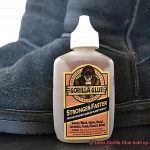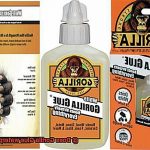Water can be a formidable force that can break down even the toughest materials. That’s why it’s crucial to find an adhesive that can keep water out when sealing surfaces. Gorilla Glue is a popular choice for many, thanks to its versatility in bonding different types of surfaces. But the question remains: Does Gorilla Glue seal out water?
The answer is a resounding yes. Gorilla Glue is a water-resistant adhesive that effectively keeps water out of sealed surfaces. However, there are essential points to consider to ensure Gorilla Glue’s water resistance works as intended.
To achieve optimal results, it’s paramount to use Gorilla Glue correctly. The surface must be clean, dry, and free from any debris before applying the glue sparingly. Remember, less is more. Too much glue can cause excessive foaming, which may compromise the glue’s water resistance.
In this comprehensive guide, we’ll delve deeper into whether Gorilla Glue seals out water by exploring the science behind waterproof adhesives. We’ll also provide tips on how to use Gorilla Glue correctly to ensure it creates a reliable and long-lasting bond that repels moisture.
So, let’s get started and discover how Gorilla Glue can help you tackle any project that requires a robust and waterproof seal.
What is Gorilla Glue?
Contents
- 1 What is Gorilla Glue?
- 2 Properties of Gorilla Glue
- 3 Does Gorilla Glue Seal Out Water?
- 4 How Does Gorilla Glue Work?
- 5 Factors to Consider When Using Gorilla Glue for Waterproofing
- 6 Advantages and Disadvantages of Using Gorilla Glue for Waterproofing
- 7 Alternatives to Using Gorilla Glue for Waterproofing
- 8 Conclusion
Are you tired of adhesives that can’t keep up with your DIY projects? Look no further than Gorilla Glue, the polyurethane-based adhesive that boasts unparalleled strength and versatility. Since its introduction in 1994, Gorilla Glue has become a household name for anyone looking to bond different materials together.
What sets Gorilla Glue apart is its unique expanding property. When activated by moisture, the glue expands as it cures, filling gaps and creating an unbreakable bond between surfaces. This feature makes it ideal for materials that are difficult to bond using other types of adhesives. Its waterproof properties also make it perfect for outdoor projects or items that will be exposed to moisture.
Gorilla Glue comes in various forms, each with its specific uses and properties. The Original Gorilla Glue can bond a wide range of materials, including wood, metal, ceramic, foam, and more. The Super Glue is perfect for quick fixes and tight spaces, while the Epoxy provides a strong bond for heavy-duty projects. Finally, the Construction Adhesive is specifically designed for construction projects and can be used on everything from drywall to brick.
While Gorilla Glue is known for its strength and versatility, it’s important to handle it with care. The expanding properties of the glue can make it difficult to control the amount used and where it goes. Additionally, repeated cycles of wetting and drying may cause it to become brittle over time.
Properties of Gorilla Glue
As an expert in the properties of Gorilla Glue, I can tell you that this polyurethane-based adhesive is a powerhouse when it comes to bonding almost any surface.
One of the most impressive properties of Gorilla Glue is its water resistance. This glue forms a barrier against moisture, making it ideal for outdoor projects or items exposed to water. It’s the perfect solution for those who want to avoid worrying about their DIY project falling apart after a rainstorm or accidental spill.
In addition to its water resistance, Gorilla Glue has the unique ability to expand slightly as it cures. This feature makes it perfect for filling gaps and cracks in surfaces, providing a secure and durable bond that can withstand even the toughest conditions. Say goodbye to pesky gaps and cracks in your project – Gorilla Glue has got you covered.
Furthermore, Gorilla Glue is renowned for its incredible strength. It can bond to almost any surface, including wood, metal, ceramics, and plastics. This versatility makes it an ideal choice for a wide range of applications, from woodworking to metalworking and beyond.
To summarize, the properties of Gorilla Glue make it an incredibly versatile and reliable adhesive for a wide range of applications. Here are some of the key benefits:
- Water resistance: ideal for outdoor projects or items exposed to water
- Expansion capabilities: fills gaps and cracks, creating a secure and durable bond
- Incredible strength: bonds to almost any surface

Does Gorilla Glue Seal Out Water?
Look no further than Gorilla Glue, the superhero of adhesives. This polyurethane-based adhesive not only bonds almost any surface with incredible strength, but it also seals out water, expanding to fill gaps and cracks and providing a secure and durable bond that can weather any storm.
How exactly does Gorilla Glue seal out water? The answer is in its chemistry. Polyurethane-based adhesives like Gorilla Glue are highly resistant to water and moisture. When applied correctly, the glue creates a strong and durable bond that can withstand exposure to water and other environmental factors.
But, how do you ensure that you’re using Gorilla Glue to its fullest potential? Here are some tips on how to use Gorilla Glue to effectively seal out water:
- Prepare the surfaces: Before applying Gorilla Glue, make sure that the surfaces to be bonded are clean, dry, and free of any debris or contaminants. If necessary, use sandpaper or a wire brush to roughen up the surface for better adhesion.
- Apply the glue: Squeeze a small amount of Gorilla Glue onto one of the surfaces to be bonded. Spread the glue evenly over the surface using a brush or a toothpick. Be careful not to apply too much glue as it may cause the bond to break.
- Clamp the surfaces: Press the two surfaces together and clamp them tightly for at least 30 minutes. The glue will expand slightly as it dries, filling gaps and cracks to create an even stronger bond.
- Let it dry: Allow sufficient time for the glue to dry and cure completely. The drying time may vary depending on the temperature and humidity levels, so make sure to follow the manufacturer’s instructions carefully.
Aside from its ability to seal out water, Gorilla Glue offers a range of other benefits that make it an ideal choice for many applications. It has excellent bonding strength, is resistant to heat and chemicals, and can be used on a variety of different materials.
How Does Gorilla Glue Work?
Gorilla Glue is a true hero among adhesives, a superhero that can bond almost any surface with incredible strength and durability and seal out water by expanding to fill gaps and cracks. But how does it work its magic?
At the heart of Gorilla Glue is polyurethane, a polymer made up of repeating units of urethane. When Gorilla Glue comes into contact with moisture, it undergoes a chemical reaction known as polymerization. This reaction causes the polyurethane to expand and cure, resulting in a strong bond.
One of the unique things about Gorilla Glue is that it can bond to both porous and non-porous surfaces, making it an ideal adhesive for both indoor and outdoor use. Its waterproof and heat-resistant properties make it perfect for areas exposed to moisture or high temperatures.
But Gorilla Glue isn’t just about bonding. Once cured, it can be sanded and painted, making it an excellent choice for woodworking projects where a strong bond is needed but the appearance of the finished product is important.
So, how does Gorilla Glue work in practice? Imagine you’re repairing a wooden chair leg that has broken in half. You apply a small amount of Gorilla Glue to one end of the broken leg and press it back together with the other half. As soon as the glue comes into contact with moisture in the air or from the wood itself, it begins to expand and cure. This fills any gaps between the two pieces of wood, creating a strong bond that will hold up over time.
Factors to Consider When Using Gorilla Glue for Waterproofing
When it comes to waterproofing your project with Gorilla Glue, there are several factors to consider to ensure a durable and effective bond. Firstly, it’s important to consider the type of surface you want to waterproof. Gorilla Glue works best on porous surfaces such as wood, fabric, or paper. However, non-porous surfaces like metal or plastic may require a different type of adhesive for waterproofing.
Secondly, the amount of glue you apply is crucial. Gorilla Glue expands as it dries, so it’s essential not to apply too much. A thin layer is usually sufficient for waterproofing purposes. Additionally, ensure that you apply the glue evenly to prevent any gaps or weak spots where water could seep through.
Furthermore, the temperature and humidity during application and drying affect the curing process. Gorilla Glue works best at room temperature and in low humidity conditions. High humidity can weaken the bond, while extreme temperatures can cause the glue to become brittle and crack over time.
Lastly, it’s essential to understand that Gorilla Glue is not a permanent solution for waterproofing. Although it provides a strong bond and seals out water for a period of time, exposure to UV rays, extreme temperatures, or other environmental factors can cause it to break down or lose its effectiveness over time. Regular maintenance and reapplication may be necessary to ensure continued waterproofing protection.
Advantages and Disadvantages of Using Gorilla Glue for Waterproofing
Gorilla Glue may be the answer you’re looking for. This popular adhesive is known for its ability to bond with various materials, making it a versatile option for waterproofing projects. However, there are advantages and disadvantages to using Gorilla Glue that you should consider before starting your project.
Advantages:
- Strong and Durable Bond: Gorilla Glue is famous for its strong and durable bond, making it ideal for waterproofing. Once cured, it can withstand water exposure without breaking down or losing its hold.
- Versatile: Gorilla Glue can bond with various materials, including metal, wood, plastic, ceramic, and more. This versatility makes it an excellent option for projects involving multiple surfaces.
- Easy to Use: Applying Gorilla Glue is a breeze. You can directly apply it to the surface that needs to be waterproofed. It also dries quickly, allowing you to finish your project in no time.
- Long-Lasting: Gorilla Glue’s strong bond and durability make it a long-lasting option for waterproofing. It can withstand exposure to water, heat, and other environmental factors without losing its hold.
Disadvantages:
- Messy Application: Applying Gorilla Glue can be messy since it expands as it dries. This can cause excess glue to seep out of the edges of the bonded surface, creating a mess that needs cleaning up.
- Not Ideal for Large Gaps: Gorilla Glue is not ideal for filling large gaps between surfaces due to its expanding nature. It works best when bonding surfaces that fit tightly together.
- Limited Time to Adjust: Once applied, Gorilla Glue sets quickly and does not allow much time to adjust the position of the bonded surfaces. This can make it difficult to achieve a perfect fit if you aren’t careful during application.
- Not Ideal for Some Materials: Gorilla Glue may not be suitable for all materials, especially those that are oily or greasy. It’s best to test the glue on a small area before applying it to the entire surface.
Alternatives to Using Gorilla Glue for Waterproofing
Silicone-based sealants are a popular choice for bathroom and kitchen applications due to their resistance to water and mold. These sealants can create a strong, waterproof bond on surfaces such as metal, glass, and plastic.
Epoxy resin is another excellent option for creating a durable, waterproof bond on a variety of surfaces, including wood, metal, and plastic. It’s a top choice for boat building and other marine applications because of its ability to withstand water exposure.
For outdoor projects, polyurethane-based sealants are an ideal substitute for Gorilla Glue. These sealants are designed to resist weathering and UV rays, ensuring a long-lasting and waterproof seal on surfaces like concrete and wood.
When you’re in a pinch for a small waterproofing project, consider using waterproof tape made from materials like rubber or PVC. This tape can provide a tight seal on surfaces like pipes or hoses, giving you peace of mind that your project is protected.
ESGJm8em6tA” >
Also Read: Is Super Glue Waterproof? – Glue Things
Conclusion
In summary, Gorilla Glue is the go-to adhesive for anyone seeking a waterproof solution that can withstand even the harshest conditions. Its expanding properties and polyurethane-based formula make it perfect for bonding almost any surface while also keeping water at bay. However, to achieve optimal results, it’s crucial to apply Gorilla Glue correctly by preparing surfaces, using it sparingly, clamping them tightly and allowing ample time for drying.
Apart from its water resistance, Gorilla Glue boasts several other advantages that make it an excellent choice for many applications. It offers exceptional bonding strength, resists heat and chemicals, and works on various materials. Nevertheless, some setbacks come with using Gorilla Glue such as messy application and limited adjustment time once applied.
If you’re looking for alternatives to Gorilla Glue for waterproofing purposes, consider silicone-based sealants, epoxy resin, polyurethane-based sealants or waterproof tape depending on your project’s specific needs.






